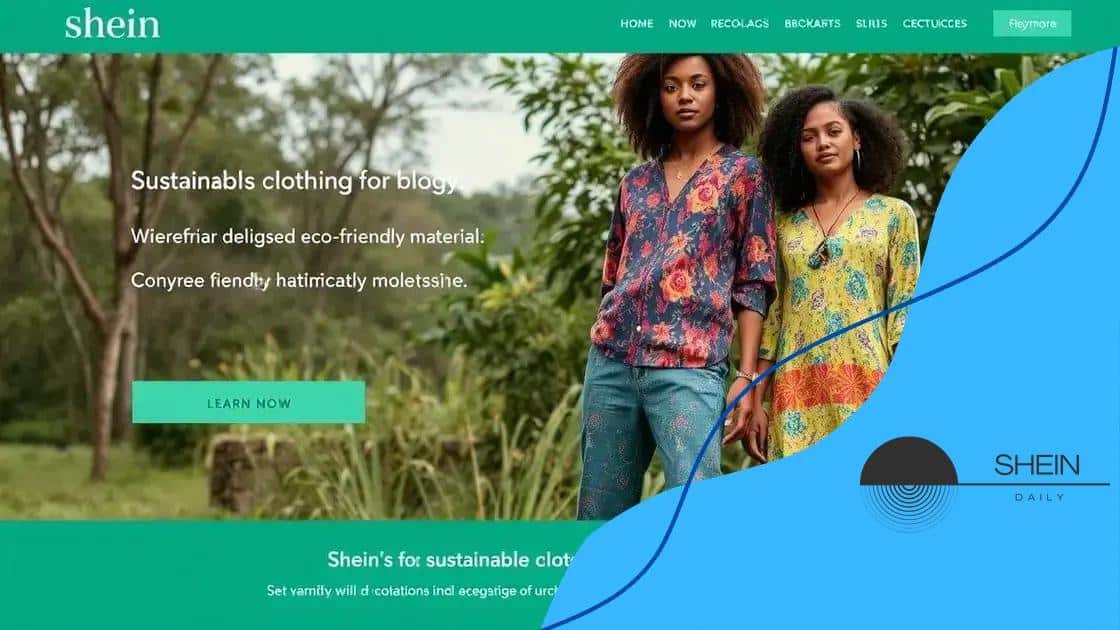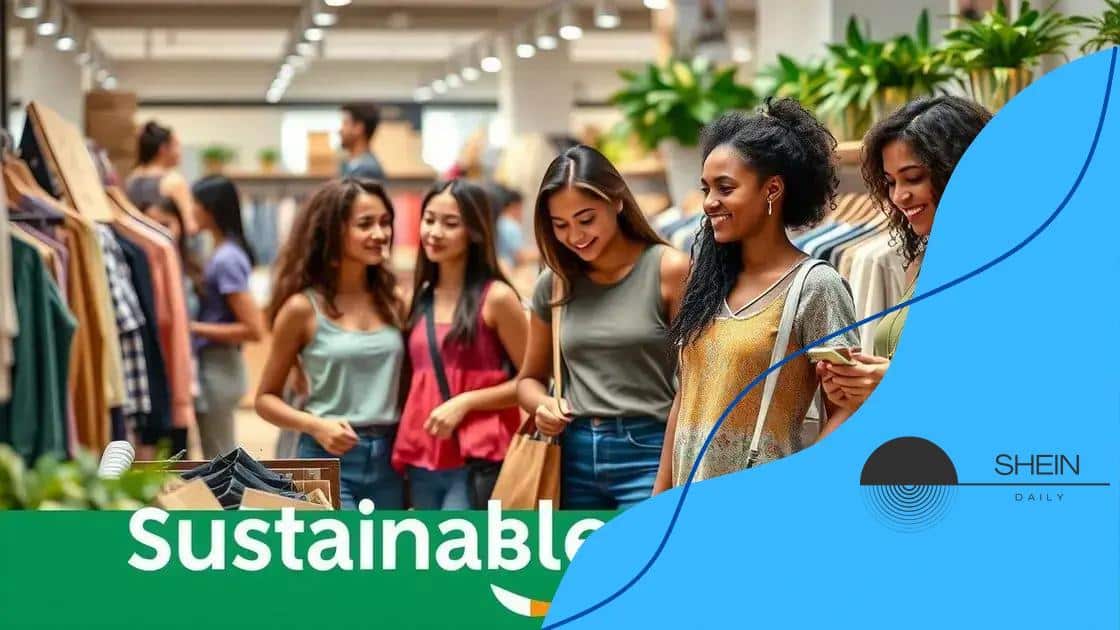Environmental benefits from Shein’s sustainable lines

Environmental benefits from Shein’s sustainable lines include the use of eco-friendly materials, reduced waste through innovative production, and increased consumer engagement in sustainable practices, making fashion more responsible.
Environmental benefits from Shein’s sustainable lines are becoming increasingly relevant as more consumers seek eco-friendly options without sacrificing style. Have you ever considered how your fashion choices affect the planet? In this article, we’ll delve into Shein’s efforts to promote sustainability and what it means for the future of fashion.
Understanding Shein’s sustainable initiatives
Understanding Shein’s sustainable initiatives is essential for consumers who care about the environment. Shein has made significant changes to address sustainability in fashion. By focusing on eco-friendly materials and better production practices, they aim to reduce their environmental impact.
Key Sustainable Practices
One of the standout commitments from Shein is their incorporation of sustainable practices throughout their supply chain. This includes:
- Using organic cotton and recycled polyester
- Reducing water usage during production
- Implementing eco-friendly packaging solutions
Moreover, Shein promotes a circular fashion model by encouraging recycling and upcycling in their customer base. They are not just a clothing brand; they are working to change how customers think about fashion. For instance, their “Shein Cares” program aims to educate consumers about the benefits of sustainable shopping.
The Role of Technology
Technology plays a crucial role in Shein’s sustainable initiatives. By utilizing advanced analytics, they can predict trends and manage inventory effectively. This reduces overproduction, which is a major issue in the fashion industry. Also, Shein is exploring the use of digital twinning which helps in creating virtual models before physical fabrics are produced.
This proactive approach not only minimizes waste but also allows Shein to offer styles that are timely and relevant. Shein’s commitment to sustainability undoubtedly positions them as a leader in the fast fashion revolution.
Overall, by focusing on sustainable initiatives, Shein is making strides towards a more responsible future in fashion. They prove that it is possible to combine style with sustainability, ultimately benefiting both consumers and the planet. By being aware of these practices, consumers can make informed choices that support a more sustainable future.
The materials powering sustainability
The materials powering sustainability at Shein are key to their eco-friendly initiatives. By choosing the right materials, Shein aims to minimize its environmental footprint while still offering trendy fashion options. These materials not only reduce waste but also improve the overall sustainability of the clothing produced.
Eco-Friendly Materials
Shein embraces several types of materials that are better for the planet. Some examples include:
- Organic Cotton: Grown without harmful pesticides, this cotton reduces chemical use and promotes healthier farming practices.
- Recycled Polyester: Made from recycled plastic bottles, this material helps divert waste from landfills.
- Linen: A natural fiber that requires less water and pesticides compared to conventional materials.
In addition to these options, Shein explores other innovative fabrics made from sustainable sources. For instance, fabrics derived from banana fibers or eucalyptus trees are being researched and introduced into collections.
The Benefits of Sustainable Materials
Using sustainable materials offers several benefits for both the environment and consumers. These materials often reduce water usage during production, which is a significant factor in fighting climate change. Furthermore, they contribute to a circular economy by promoting recycling and reducing waste.
Moreover, when consumers buy clothes made from sustainable materials, they feel more connected to the impact of their purchases. This consciousness leads to a more mindful approach to fashion and purchasing decisions. By choosing items made from eco-friendly fabrics, shoppers support the fashion industry’s shift toward sustainability.
Ultimately, the materials Shein uses play a crucial role in their commitment to sustainability. By prioritizing these eco-friendly options, they are paving the way for a more responsible future in fashion, making it easier for consumers to make choices that benefit the planet.
How sustainable lines impact consumer choice

How sustainable lines impact consumer choice is a critical topic in today’s fashion industry. Consumers are becoming more aware of the impact their purchasing decisions have on the environment. As a result, sustainable lines are playing a significant role in shaping these choices. People are not just looking for stylish clothing; they are also considering the ethical implications of their purchases.
The Shift in Consumer Preferences
More and more shoppers are prioritizing sustainability. This shift is evident in several ways, such as:
- Increased Demand: A growing number of consumers prefer to buy from brands that offer sustainable options.
- Brand Loyalty: Shoppers often remain loyal to brands that demonstrate a commitment to sustainability.
- Social Media Influence: Many people are influenced by social media, where discussions about sustainability and ethical practices are common.
The younger generation especially values sustainability, often driving trends toward eco-friendly products. As they share their thoughts on platforms like Instagram and TikTok, they help raise awareness among their peers.
Real-World Impact on Brands
Sustainable lines are not just a trend; they are transforming brand strategies. Companies like Shein are recognizing the need to adapt their offerings to meet consumer demands. They are investing in sustainable materials and production techniques to appeal to eco-conscious shoppers.
When brands focus on sustainability, they often attract a wider audience. Consumers who might have avoided fast fashion due to its negative reputation can find comfort in sustainable lines. These offerings help bridge the gap between style and ethical choices, making it easier for shoppers to align their wardrobe with their values.
Moreover, companies reporting on their sustainability efforts can enhance their image. Transparency about materials used and production processes instills trust in consumers. This accountability can make a significant difference, leading to positive brand perception and stronger customer relationships.
Comparing environmental impact with traditional fashion
Comparing environmental impact with traditional fashion reveals the significant differences in sustainability practices between brands like Shein and more traditional fashion labels. As consumers become increasingly aware of the effects of their buying habits, understanding these differences is crucial for making informed choices.
Environmental Footprint of Traditional Fashion
Traditional fashion brands often rely on mass production techniques that contribute to environmental degradation. Some key issues include:
- Excessive Waste: Fast fashion frequently results in overproduction, leading to piles of unsold clothing that end up in landfills.
- High Resource Consumption: Traditional brands require a significant amount of water and energy to produce garments, which depletes natural resources.
- Chemical Pollution: The use of harmful chemicals in dyeing processes can pollute waterways, affecting local ecosystems.
These practices create a heavy burden on the environment and contribute to climate change. Many consumers are reevaluating their support for brands that prioritize speed over sustainability.
Sustainable Practices in Fashion
In contrast, brands like Shein are working to integrate sustainability into their practices. This shift can be seen in several areas:
- Ethical Sourcing: Utilizing materials sourced from suppliers that prioritize sustainable farming and manufacturing methods.
- Innovative Production Techniques: Implementing practices that minimize waste and energy use, such as on-demand production.
- Transparency: Offering clear information about sourcing and production processes to build trust with consumers.
As a result, the fashion industry is experiencing a shift towards more environmentally friendly approaches. This transition is not just beneficial for the planet; it also attracts consumers who wish to support brands with strong sustainability values.
By comparing the environmental impacts of traditional fashion versus sustainable lines, it becomes clear that consumers have the power to drive change. Every purchase can influence the industry’s approach to sustainability, encouraging brands to adopt more responsible practices.
Future of sustainable fashion at Shein
The future of sustainable fashion at Shein is an exciting topic that reflects the brand’s commitment to eco-friendly practices. As aware consumers demand more from the fashion industry, Shein is positioned to lead in sustainability. Their focus is on creating stylish clothing while minimizing environmental impact.
Innovative Approaches
Shein is adopting several innovative strategies to enhance sustainability. These include:
- Advanced Technologies: Utilizing technology to reduce waste and enhance production efficiency, such as automated systems for better inventory management.
- Eco-Friendly Materials: Continuing to expand their use of sustainable fabrics, including organic cotton, recycled polyester, and other innovative materials that have a lower environmental footprint.
- Collaborations: Partnering with environmental organizations to promote awareness and develop better practices in production and supply chain management.
By integrating these approaches, Shein is not only catering to current market demands but also setting a benchmark in the industry.
Consumer Engagement
Shein understands the importance of engaging with its consumers on sustainability. The brand encourages customers to participate in initiatives like recycling programs and fashion swaps. This engagement fosters a community of environmentally conscious shoppers. By highlighting sustainable choices, Shein gives consumers the power to make informed decisions about their purchases.
Moreover, transparency is becoming a key focus for Shein. By sharing insights into their sustainability practices, they aim to build trust with their customers. Making information readily available about materials used and production methods can significantly influence consumer decisions.
All these efforts contribute to a sustainable future for Shein. As the brand continues to evolve, it seeks to inspire others in the fashion industry to adopt similar practices. This transformation is vital not only for the brand’s growth but also for the planet’s health.
The fashion industry is at a turning point, with brands like Shein leading the way in sustainability. By focusing on eco-friendly materials, innovative production practices, and engaging consumers, Shein is reshaping how we think about fashion. As we look to the future, it’s clear that sustainable practices will not only benefit the environment but also appeal to a growing number of conscious consumers. This shift is essential for fostering a healthier planet and a more responsible fashion industry. Here’s a summary of the key points regarding the future of sustainable fashion at Shein:
FAQ – Frequently Asked Questions about Shein’s Sustainable Fashion
What sustainable materials does Shein use?
Shein uses various eco-friendly materials, including organic cotton and recycled polyester, to reduce their environmental impact.
How is Shein engaging consumers in sustainability?
Shein encourages consumer participation through recycling programs and initiatives that promote sustainable fashion choices.
What role does technology play in Shein’s sustainable practices?
Technology helps Shein optimize their production processes, reduce waste, and enhance inventory management for a more efficient operation.
Why is transparency important for Shein’s brand?
Transparency builds trust with consumers, as it provides clear information about their sustainability efforts and production methods.





